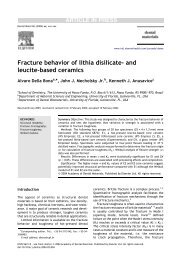Microtensile bond strength of a filled vs unfilled adhesive to dentin ...
Microtensile bond strength of a filled vs unfilled adhesive to dentin ...
Microtensile bond strength of a filled vs unfilled adhesive to dentin ...
Create successful ePaper yourself
Turn your PDF publications into a flip-book with our unique Google optimized e-Paper software.
<strong>Microtensile</strong> <strong>bond</strong> <strong>strength</strong> <strong>of</strong> <strong>adhesive</strong> <strong>to</strong> <strong>dentin</strong> using self-etch and <strong>to</strong>tal-etch technique 289<br />
Figure 5 Scanning electron micrograph <strong>of</strong> the fractured<br />
surface <strong>of</strong> One-Step Plus <strong>to</strong>tal-etch group showing<br />
mixed failure. d: cohesive in <strong>dentin</strong>, b: cohesive in<br />
<strong>bond</strong>ing resin, a: <strong>adhesive</strong> failure.<br />
<strong>adhesive</strong>s, although they have different viscosities<br />
because <strong>of</strong> the 8.5% filler load. Moreover, similar<br />
<strong>bond</strong> <strong>strength</strong>s <strong>to</strong> <strong>dentin</strong> may be due <strong>to</strong> the<br />
application <strong>of</strong> resin composites <strong>to</strong> a flat <strong>dentin</strong><br />
surface because the polymerization shrinkage <strong>of</strong><br />
the composite resin would minimize stress at the<br />
<strong>bond</strong>ed interface. 26<br />
Stress distribution during tensile testing<br />
between <strong>filled</strong> and un<strong>filled</strong> <strong>adhesive</strong>s has been<br />
expected <strong>to</strong> be different because <strong>adhesive</strong>s containing<br />
fillers showed higher elastic modulus than<br />
un<strong>filled</strong> resins. 25 However, the failure modes <strong>of</strong> the<br />
<strong>filled</strong> and un<strong>filled</strong> <strong>adhesive</strong>s with <strong>to</strong>tal-etch technique<br />
(Figs. 5 and 7, respectively) were similar<br />
Figure 6 Scanning electron micrograph <strong>of</strong> the fractured<br />
surface <strong>of</strong> One-Step Plus self-etch group showing<br />
<strong>adhesive</strong> failure.<br />
Figure 7 Scanning electron micrograph <strong>of</strong> the fractured<br />
surface <strong>of</strong> One-Step <strong>to</strong>tal-etch group showing<br />
mixed failure. a: <strong>adhesive</strong> failure, b: cohesive in <strong>bond</strong>ing<br />
resin.<br />
showing predominantly mixed failure (Figs. 5<br />
and 7, respectively) and also similar with the<br />
self-etch technique showing <strong>adhesive</strong> failure<br />
(Figs. 6 and 8, respectively). This may be due <strong>to</strong><br />
the fact that the application <strong>of</strong> a thin layer <strong>of</strong> a<br />
more flexible <strong>adhesive</strong> (lower elastic modulus)<br />
(Figs. 3(A) and 4(A)) led <strong>to</strong> the same stress relief as<br />
thick layers <strong>of</strong> a less flexible <strong>adhesive</strong> (higher<br />
elastic modulus) 34 (Figs. 1(A) and 2(A)).<br />
Self-etch <strong>adhesive</strong>s have been classified on their<br />
ability <strong>to</strong> penetrate smear layers and their depth <strong>of</strong><br />
demineralization in<strong>to</strong> the subsurface <strong>dentin</strong> as<br />
mild, intermediary strong and strong. 16,35 The<br />
self-etching primer Tyrian SPE used in this study<br />
Figure 8 Scanning electron micrograph <strong>of</strong> the fractured<br />
surface <strong>of</strong> One-Step self-etch group showing<br />
<strong>adhesive</strong> failure.
















